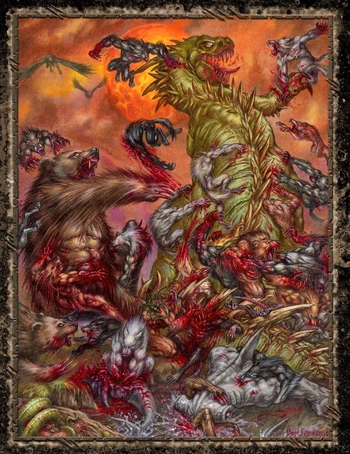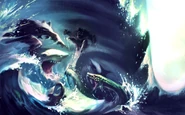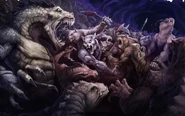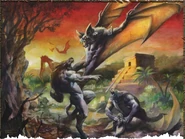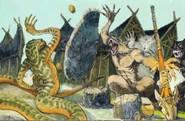The War of Rage was an ancient war fought between the Garou and the other Fera. It happened before start of recorded history. Sources differ on whether it occurred before or after the Impergium.
First War of Rage[]
Sources differ on why exactly the War of Rage started. All sources point to the Garou as being the aggressor. Some sources say they sought to make themselves the kingship of all Gaia's children and force the other Changing-Breeds submit to their sole rule. Some Fera claim it is because the Garou demanded they show them secret powers granted them by Gaia that had not been meant for the Garou. There was not one single trigger for the War of Rage, but several circumstances that played into each other and resulted in massacres and genocide.
While some of the Fera are physically or spiritually more powerful in a one-on-one fight with the Garou, the werewolves had the advantage of fighting in packs. They picked off the solitary Fera one by one, driving some entire Breeds to extinction.
Ananasi[]
The Ananasi tell that they came under the scrutiny of the Garou first when they served the Wyrm in order to keep their imprisoned Mother-Queen safe. The other Changing Breeds did not understand them and lashed out against them for an alleged betrayal of Gaia. The Ananasi claim that the Garou used the charges against them as excuses to attack other Fera. The animosity between the werespiders and werewolves had long festered, since the Ananasi were sent against the Insect Races and the Garou had been elevated to their state as Gaia's Fangs and both found their particular duties in conflict. As the Ananasi did not care about the laws of the Impergium, instead taking the blood of humans whenever they pleased, the Garou became furious at them. In order to spite them, the Ananasi spread word of the werewolves' arrogance, leading whole Breeds to attack the wolves and unknowingly cementing their aggressiveness and pride even more.
The werespiders claim that they ended the War of Rage, however, via a ruse of Anansi, favoured child of Ananasa. He had found the opal-prison of his mother in the depths of Malfeas and was determined to free her. With the aid of various Corax, he spread word of the Heart of the Wyrm inside Malfeas and that if it would be shattered, the Wyrm's influence would abide, withholding that the heart was, in truth, the prison of Ananasa. The Garou, yearning for glory, abandoned the slaughter of their brethren and started a great crusade into Malfeas to reclaim the prison, attacking it without relenting. Their efforts, along with Ananasa's own power, created a crack in the opal that allowed her to communicate with her children and others without being affected by the Wyrm's Taint. When the Garou learned that they had been deceived, they howled in rage and doubled their efforts in finding and killing the fera, only to discover that nearly all of them had vanished.
Bastet[]
According to the oral traditions of the Bastet, they were created to complement the other Changing Breeds in their task. Many of them, however, refused their help, believing themselves capable of managing their affairs alone.[1] This refusal hurt the pride of the werecats and they refused to aid their brethren until amends were made. The Garou reacted poorly to what they perceived to be treason of the Bastet's duty under Gaia and assumed that the Bastet, if they refused to cooperate with the Garou, had fallen to the Wyrm. Thus, the first battles began. The Bastet fought the War of Rage against the Garou with equal ferocity, but because of their solitary nature, most tribes found themselves overwhelmed in the heartlands of Garou territory.[2] Eventually, they would shrink back and concentrate on defending their own core territories, where their own Kin were native. As a result, the overall Bastet population is slightly more populous than other Fera, as many lived in territories without native wolves or chose reclusive territories like mountain ranges or rainforests as their home. Some Garou tribes, however, eventually made amends; like the Pure Tribes in the West, the Stargazers and Silent Striders were tolerated in Bastet territory. Most of the losses of the modern Bastet can, instead, be attributed to humans and the breed's own petty conflicts, especially among the Simba and Khan.
The War of Rage scarred the Bastet tribes on a spiritual level, inflicting them with a deep-seated hatred against the Garou similar to the Delirium that afflicts humans. Only with great restraint can a Bastet overcome this hatred and even then, it is only temporary. Some Bastet also blame the Garou for their inability to step sideways.
Corax[]
The Corax claim that the War of Rage was the result of the indifference of the other Fera towards humans. The Garou were the only ones that concentrated on dominating her human herds and, on the way, decided to duplicate the coup with the other Changing Breeds. The Silver Fangs were the most pretentious and when they demanded secrets from the Gurahl and were refused, they answered with violence and also led preemptive attacks against those Fera allied with the werebears, bringing all other Changing Breeds against them.
The Corax tried to mitigate the crisis by leading the Fera into safe havens, while aiding the Garou by bringing them info to save their own cordial relations with the Nation. The plan worked, today, the Corax are among the few Fera the Garou tolerate and even accept, and their numbers have remained relatively stable.
Garou[]

Garou glyph signifying the War of Rage.
Many Garou of the Final Nights have agree that the War of Rage was a bad idea. Some tribes, like the Silver Fangs and the Get of Fenris and Red Talons, defend their reasons for starting the war, but even among them some individuals agree that a different solution should have been found. Most Garou, however, believe that they are not responsible for the crimes of their Ancestors and that the Fera, in maintaining their grudge, only harm Gaia. Despite this, many Garou continue to attack Fera when convenient, stealing their lands and fetishes, such as in the Amazon rainforest.
The Fianna more or less regret their part in the War, citing pride as the main reason for the First Great Sin against Gaia[3]. The Silent Striders remember that the main reason among the Garou to attack the Fera was their lack of commitment to the Impergium, and they remember with shame that many of their own took joy in proving themselves in battle against their cousins.[4]
The Children of Gaia claim that they tried to remain neutral, but were used by both Fera and Garou for their own agendas. Fera would seek sanctuary in their Caerns, only to turn against the Children, and Garou would send Children as mediators, only to attack the arrivals in the peace meetings.[5] The Stargazers cite a similar involvement, pointing to the greed of the Garou for the secrets of the Fera as the main reason for the War.
The Black Furies and Bone Gnawers, too mired in mortal history and their own tragedies and battles, rarely speak of their part in the conflict, although they do not deny their involvement. The Glass Walkers blame themselves for the War, citing their intrusion into Fera territory along with human cities as one of the main reasons things got out of hand.[6] The Red Talons remember the arrival of the Fenrir Greycoat,[7] who was an ambassador of the Silver Fangs and incited the Talons against the Fera. They obeyed because the Fangs were the Alpha Tribe and they trusted the judgement of their Alpha.
The Get of Fenris, while pointing at their right to lead the other Fera as Gaia's strongest children and that the refusal of the other Changing Breeds to submit to their authority was a sin against Gaia, accept that their way to solve the situation was dishonorable and only harmed Her in the long run.[8] The Shadow Lords cite provocations on the Fera's behalf for not accepting the supremacy of the werewolves in Gaia's heart, but also accept that the Garou did not understand the duties of their cousins and thus failed to accept them as a part of Gaia's plan.[9] Recently, the tribe has made begun to make amends for the destruction of the Camazotz, hoping to heal Bat from his madness and grief.
The Silver Fangs cite the inability of the other Fera to properly conduct their duties to Gaia and their defense of their Kinfolk against the Impergium as the main reasons of the War and even state that they were the ones who ended the conflict by granting them territories and Kinfolk to sustain on their own after Garou dominance was established,[10] although the Lodge of the Moon claims that one of the Kings of the Lost Houses was the one who declared the War after he had succumbed to the curse of Luna that plagues the Tribe.[10]
The Uktena, Croatan, and Wendigo tribes participated less in the conflict, but still waged war in North America against the Simba, Swara, and Camazotz there, but in time made peace with the surviving Native American Fera and aided them against the European invaders.
The Bunyip abstained from the war, while the involvement of the White Howlers is lost to history.
Gurahl[]
The werebears believe themselves responsible for the war, because they refused the Gift of Gaia's Breath to the Garou. They also assert that their decision was the right one, as the gift is highly dangerous and should only be used with great caution, something the werewolves lacked.[11] The Garou first reacted by slandering the Gurahls' good reputation, telling the other Fera that they hoarded their knowledge and refused to share and were in league with the Wyrm. Because the Garou were tasked with fighting the Wyrm, many Fera believed their counsel and began to avoid the Gurahl, isolating them. During the Ice Age, tensions escalated as the Garou believed the Gurahl responsible for the drop in temperature and that they sought to drive the Garou off. In the end, the Silver Fangs declared war on the Gurahl and the werebears responded in kind, their Rage finally unleashed. The Garou were the dominant force in the conflict and many werebears died. Some packs also targeted the Kin of the Gurahl, killing bears and subjugating their human families, torturing them for information about the secrets of the werebears..[12]
The Gurahl Gift of Prophetic Vision saved some Gurahl, although some misinterpreted or ignored the warnings that it gave.[13] The majority choose to enter hibernation and sleep the conflict away, hoping to awake in a time when the Garou's fury would have calmed down. The Gurahl subsequently created the Rite of the Ban to protect themselves against inadvertently giving information to their enemies..[14] In the Pure Lands, the Gurahl population was somewhat stable, although many Gurahl choose to enter hibernation as well, while the Asian branch was eradicated in the War of Shame.
Kitsune[]
The Kitsune did not participate in the War of Rage, as they were still non-existent.
Mokole[]
The Mokolé, even those most well versed with the use of Mnesis, cannot recall the exact beginning of the War of Rage, but generally know all the other reasons the other Changing Breeds presume. They usually ascribe the reason for the downfall of Gaia's children to their own foolishness, as they remember territorial strife, contests for the best breeding stock or herds, or simple reasons like pride and spite. Most Mokolé, however, remember the atrocities of the wolves the clearest from all Changing Breeds. Defiled Wallows, smashed eggs, alleged peace meetings that were used to slay the participating weresaurians from behind, and several other crimes against them have made them bitter and untrusting to the Garou. That the werewolves spread the picture of their Drachid forms as monsters, abetted their Kin against them and even named the Unmaker itself after their reptilian nature, only added to the insults heaped against them.
In some regions, the Mokolé managed to forgive the Garou if they made amends, most famously in Australia, where they aided the Bunyip in assimilating in the local fauna, and in Africa, where they helped a group of Red Talons known as the Kucha Ekundu to adopt the wild dogs of the savanna as Kin. Many others, however, still do not fully trust the Garou and consider them still unrepentant, preserving the memory of their crimes for the future
Nagah[]
According to the Nagah, the first War of Rage took place because Vinata, a Wyrm-corrupted Nagah, slew Petros the Unyielding, a Silver Fang Ahroun who was carrying a message to Konstantos the Savage of the Silver Fangs to the west to stop harassing the other Fera. Konstantos blamed a Bubasti for Petros' death, and killed him. Konstatos then demanded that the Gurahl resurrect Petros, but the Gurahl refused, believing that the Nagah acted properly, and the Garou frenzied and attacked. The surviving Gurahl of the attack begged sanctuary from the Grondr. The Gurahl and Grondr attacked the Garou in retaliation, and the conflict spun out of control. [15] The Fianna wiped out the Nagah in Ireland and killed every single snake there.[15] In the Final Nights, common knowledge is that the Breed became extinct.
Ratkin[]
The Ratkin have a particular hatred for the Garou as the War of Rage drove one of their whole aspect, the Bards to extinction. Their version of the War of Rage is that the Rage, which is the inherent spark of the Wyrm invested in all Fera, corrupted the werewolves and drove them against Gaia.[16] Ratkin numbers have since rebounded, but they have never recovered the lost Aspect. (Ratkin aspects are similar to Garou auspices.)
Garou attacked the gathered Bards on the "Field of Nettles", where their last act was to bring a great (but unspecified) curse upon the Garou race. The massacre initiated the great Exodus of the rat-changers into the Umbra, to recuperate their numbers and eventually return to bring the end of human civilization.
Rokea[]
Due to their native territory being the sea, the Rokea have not been affected in great numbers by the War of Rage. To listen to them, the War was inevitable because the purpose of the Garou is fundamentally flawed. The Apocalypse cannot be defeated, just like an army cannot defeat a tsunami and all that remains is survival.[17] The Garou did not realize this and instead searched for a great enemy to defeat. They found none and instead turned on their brethren, murdering and killing them in the thousands. Some especially old Rokea have still no idea that the original War of Rage has ended, given the treatment between the Garou and their brethren.
Conclusion of the First War of Rage[]
In short, the first War of Rage (in effect, every War of Rage) was a conflict without winners and many losers. Entire Changing Breeds were eradicated, their duties neglected and forgotten. The unity of Gaia's children, never strong to begin with, collapsed and only in some institutions, like the Beast Courts of Asia or the Ahadi of Africa, is cooperation now possible. The Garou, in their quest to be rule all of Gaia's children, had accomplished only to become the sole tenders of Her, a duty too much even for their Nation.
Second War of Rage[]
Some races of Fera were largely spared from the War of Rage. The Fera native to the Americas were largely spared, as were the Rokea. The American Fera instead suffered through the Second War of Rage when the European tribes arrived and attacked them. The native Uktena and Wendigo often helped the native Fera evade the European Garou, which just resulted in the European Garou attacking the native Garou.
The Camazotz were driven extinct in Europe during the first War of Rage, but survived in South America and Mesoamerica until the Second War of Rage. The Shadow Lords are generally blamed for killing the last Camazotz and have a camp dedicated to trying to make amends for driving the breed to extinction.
Other Wars[]
While not as disastrous as the campaigns of the Garou, the War of Shame and the War of Tears also claimed the lives of entire species of Gaia's children. Black Tooth's 1984 Hyena Court Massacre and subsequent purges all but destroyed the Ajaba werehyenas.
Gallery[]
References[]
- ↑ WTA: Players Guide to the Changing Breeds, p. 52
- ↑ WTA: Bastet, p. 36
- ↑ WTA: Tribebook: Fianna, p. 15
- ↑ WTA: Tribebook: Silent Striders, p. 15
- ↑ WTA: Tribebook: Children of Gaia, p. 27
- ↑ WTA: Tribebook: Glass Walkers, p. 16
- ↑ WTA: Tribebook: Red Talons, p. 21
- ↑ WTA: Tribebook: Get of Fenris, p. 17
- ↑ WTA: Tribebook: Shadow Lords, p. 13
- ↑ 10.0 10.1 WTA: Tribebook: Silver Fangs, p. 25-26
- ↑ WTA: Gurahl, p. 26
- ↑ WTA: Gurahl, p. 28
- ↑ WTA: Gurahl, p. 98
- ↑ WTA: Gurahl, p. 106
- ↑ 15.0 15.1 WTA: Nagah, p. 29-30
- ↑ WTA: Ratkin, p. 23
- ↑ WTA: Rokea, p. 25
- WTA: Werewolf Players Guide, p. 137 (First Mention)
- WTA: Werewolf Players Guide Second Edition, p. 129-130
- WTA/cMET: Laws of the Wild: Changing Breeds 1, p. 107-108, 122
- WTA/cMET: Laws of the Wild: Changing Breeds 2, p. 15-16, 107-108
- WTA/cMET: Laws of the Wild: Changing Breeds 4, p. 13-18

